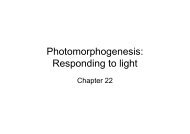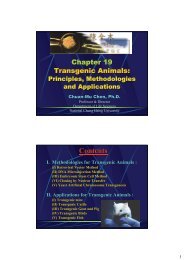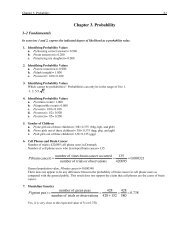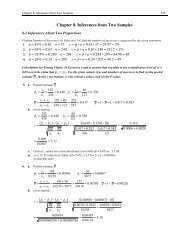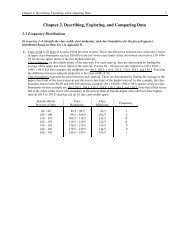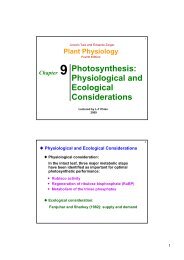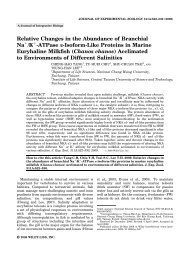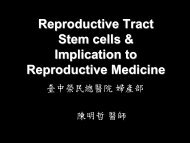Chapter 7. Hypothesis Testing with One Sample
Chapter 7. Hypothesis Testing with One Sample
Chapter 7. Hypothesis Testing with One Sample
Create successful ePaper yourself
Turn your PDF publications into a flip-book with our unique Google optimized e-Paper software.
<strong>Chapter</strong> 7: <strong>Hypothesis</strong> <strong>Testing</strong> <strong>with</strong> <strong>One</strong> <strong>Sample</strong> 207In a right-tailed test at the 0.01 significance level, the critical value is z α= z .01= 2.33.Since this is a right tailed test, the P-value is the area to the right of the test statistic. Using Table A-2, we findthat the P − value = 1− 0.9943 = 0.005<strong>7.</strong>We reject the null hypothesis.The sample data support the claim that the proportion of girls born when using this method of gender selectionis greater than 0.5.In Exercises 7-18, test the given claim. Identify the null hypothesis, alternative hypothesis, test statistic, P-valueor critical value(s), conclusion about the null hypothesis, and final conclusion that addresses the original claim.Use the P-value method unless you instructor specifies otherwise.<strong>7.</strong> Cloning SurveyFirst, we check the requirements. The sample appears to be a simple random sample The conditions for abinomial are satisfied. The sample size is 1012 <strong>with</strong> the claim that less than 10% of adults say human cloningshould be allowed, making p = 0.10, so np = 1012 × 0.10 = 101.2 and nq = 1012 × 0.90 = 910.8. Therequirements are satisfied.The claim is that less than 10% of all adults say that human cloning should be allowed, so this is a left-tailedtest. The sample proportion is p ˆ = 0.09.H 0 : p = 0.10H 1 : p < 0.10The test statistic is z = p ˆ − p =pqn0.09 − 0.100.10 × 0.901012=−1.060In a left-tailed test at the 0.05 significance level, the critical value is −z α=−z .05=−1.645.Since this is a left tailed test, the P-value is the area to the left of the test statistic. Using Table A-2, we findthat the P − value = 0.1446.We fail to reject the null hypothesis.There is not sufficient sample evidence to support the claim that less than 10% of all adults say that cloning ofhumans should be allowed. A newspaper could run the headline, but the headline is unsupported by the sampleevidence.8. <strong>Testing</strong> Lipitor for Cholesterol ReductionFirst, we check the requirements. The sample does not appear to be a simple random sample, but the subjectsmay comprise a random sample that is representative of the population. The conditions for a binomial aresatisfied. The sample size is 863 <strong>with</strong> the claim that the percentage of treated patients <strong>with</strong> flu symptoms isgreater than the 1.9% rate for patients not given the treatments, making p = 0.019, sonp = 863× 0.019 = 16.397 and nq = 863× 0.981 = 846.603. The requirements are satisfied.The claim is that more than 1.9% of all those receiving Lipitor treatments have flu symptoms, so this is a righttailedtest. In the sample, 19 had flu symptoms. The sample proportion is p ˆ = x / n = 19 /863 = 0.022.H 0 : p = 0.019H 1 : p > 0.019The test statistic is z = p ˆ − p 0.022 − 0.019= = 0.646pq 0.019 × 0.981n 863In a right-tailed test at the 0.01 significance level, the critical value is z α= z .01= 2.33.Since this is a right tailed test, the P-value is the area to the right of the test statistic. Using Table A-2, we findthat the P − value = (1 − 0.7422) = 0.2578.We fail to reject the null hypothesis.There is not sufficient sample evidence to support the claim that more than 1.9% of all those receiving Lipitortreatments have flu symptoms. It does not seem that flu symptoms are an adverse reaction to the treatment.




